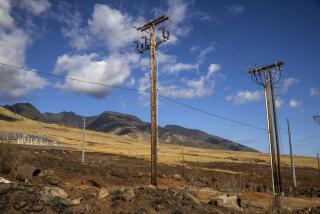Woodpeckers : The Bill Is Staggering for Utilities
The discovery of electricity and the invention of the telephone created a vast new world for mankind.
But consider what these advances meant for the woodpecker.
They brought the bird a delicious new treat--the telephone pole.
The poles, it seems, are a woodpecker’s dream, a delicacy now widely available all over the world.
The woodpecker’s taste for power poles, however, is costing utility companies millions of dollars a year.
In Alabama, a utility company spokesman said woodpeckers capable of hollowing out cavities several feet deep are destroying more than a pole a day.
$3 Million in Damage
“We spent more than $3 million last year replacing poles because of woodpecker damage. That’s about half of our total pole replacement cost,” said Ed Crosby at the Alabama Power Co., which serves two-thirds of the state.
Outside Tampa, Fla., woodpeckers so weakened a power pole recently that it snapped in two, triggering a chain reaction that downed the electrical line and overloaded a transmission substation. More than 100,000 people lost power for more than an hour, said Brock Lucas at Florida Power, which has experienced “a massive problem” with woodpeckers in forested parts of the state.
In California, the damage extends from northeast San Diego County, through the foothills of Santa Barbara, the San Joaquin Valley, the Sierra and the Northern California wine country.
Officials at Pacific Gas & Electric Co. in San Francisco estimate that woodpeckers damage between 200 and 300 poles a year, costing an annual $250,000.
At the Southern California Edison Co., which serves a 50,000-square-mile chunk of the Southland, including Los Angeles, timber specialist Robert Crosno said he has seen poles that look like they have been machine gunned from the ground all the way to the top.
Random Selection
“There’s a certain capriciousness about which poles they attack,” Crosno said. One pole may be untouched, while a short distance away another one is riddled.
In some cases the damage is so severe that the pole must be replaced immediately, Crosno said. At the very least, the openings must be filled to prevent water damage and rot. And this can be a challenge for repairmen who risk stepping in a hole as they climb and losing their footing--or surprising a hole’s occupants, known to have included not only woodpeckers but wasps and snakes.
“We’ve tried wrapping the poles in plastic mesh and using other devices like splints,” Crosno said. “Ultimately, the damage cuts down on the life span of the pole,” he said.
For decades, utility companies have been experimenting with ways to repel woodpeckers. The poles have been wrapped in steel mesh or lacquered with sticky, greasy goo. Rubber snakes and other decoys have even been nailed to the poles in the vain hope of spooking the birds.
Finding a repellent has been a challenge because the woodpecker is no carefree lark, but a tough and determined bird who swallows wasps whole and forsakes all song in favor of relentless drilling, its head snapping back and forth so fast that an ordinary movie camera can’t keep up.
Part of the problem in repelling them is that nobody really knows what attracts them to the poles in the first place.
It has been suggested that perhaps the poles have bugs--although this is hotly denied by utility executives. Perhaps there is something seductive about the vibration or hum of the electrical lines transmitted through the poles--although most scientists say this is far-fetched. Perhaps the pole, standing in the open, offers the woodpecker an excellent view from which to defend his territory.
Most experts agree that roosting and nesting are probably the woodpecker’s primary interests.
“Seven species of woodpeckers are responsible for serious pole damage problems in North America,” biologist John V. Dennis declared in an authoritative article in Bird-Banding, a Journal of Ornithological Investigation.
Wide Area Affected
“The damage . . . is of serious proportions in much of Texas, Southern California, many parts of the South-Central and Southern States, and in some parts of the Northeast.”
Woodpeckers’ damage is not limited to the United States.
F. J. Turcek at the Forest Research Institute in Czechoslovakia reported that woodpeckers were damaging poles in that country at a rate of “about one . . . per mile” as well as causing damage to poles in Japan, the Soviet Union, Sweden, Finland and Hungary.
One of the worst pole-wreckers is the pileated woodpecker--a large red-crested bird with a three-foot wingspan and a fondness for the tallest, most expensive newly erected telephone poles.
Capable of hollowing out huge nesting cavities up to five feet deep, the voracious woodpecker was on the verge of extinction during the early part of this century. But it has made a dramatic comeback, now frolicking as a “protected species” throughout the eastern half of the country and Pacific Northwest and busily chomping away on telephone poles.
“Off the cuff, I’d say 10% of the pole failures are caused by woodpeckers,” said James Taylor, a private consultant in Virginia who has evaluated woodpecker damage in this country as well as South Africa, Cyprus, the Middle East and Canada.
“I’ve seen a pole in Westchester County in New York which they put in on a Friday and when they came back on Monday there was a cavity chopped in the cross-arm,” he said.
No Preferences
“It doesn’t seem to make any difference whether it’s a new or an old pole,” said Oliver Queathem, purchasing agent for a small utility company outside Portland. “Treating the poles with creosote (a wood preservative) doesn’t seem to make any difference. Whether it’s cedar or fir, treated or not, when they decide to go after a pole, they go after it.”
At South Central Power Co., serving rural Ohio, manager Reno Robinett said that about $35,000 has been spent on one very important pole “so it won’t fall down in the next wind.”
The pole, which has come under perpetual attack from pileated woodpeckers, is a key link in a major transmission power line. The pole has been replaced three times during the last three years, Robinett said, and a helicopter now patrols the pole almost monthly, checking for new damage.
In Florida, utility officials pestered by persistent woodpeckers also replaced a single pole three times--the third time with a galvanized steel rod, recalled Lucas at Florida Power.
“Even that didn’t stop the pecking,” he said. “We had to re-galvanize the pole with a metal coating because of the woodpecker damage.”
Florida is so full of woodpeckers that Eugene Ake, a consultant who inspects poles for power companies, says he does not have to look beyond the state for business.
Last year, he said, he inspected 5,000 poles in Florida, discovering almost half had been damaged by woodpeckers and 1,250 had to be replaced. He said woodpeckers are “costing the utilities a fortune” across the country.
Costs Vary
The expense varies from state to state, as does the species of woodpecker.
In southeastern Texas, it is the golden-fronted and ladder-backed woodpeckers that cause the main damage, attacking the cross-arms of power poles to the point where the insulated hardware holding up the wires is exposed--or the arm even snaps off, downing the electrical line.
The damage to poles in the countryside outside San Antonio is costing the tiny Guadalupe Valley Electric Cooperative almost $100,000 annually--more than all of the damage done by wind, lightning and ice storms combined, according to manager Milton Hines.
In California and other Southwestern states, it is the acorn woodpecker that has proven to be a most enthusiastic driller, riddling telephone poles like a machine gun and shoving nuts into the openings.
This workaholic bird looks to store his nuts in practically any wooden surface--fence posts, old wagon wheels and rural cabins as well as telephone poles. Scientists once counted more than 50,000 holes in a single tree.
In one blitzkrieg attack by acorn woodpeckers on a homeowner’s water storage tank outside Flagstaff, Ariz., the birds riddled the wooden top of the tank with holes and dropped in a hoard of nuts.
Purple Water
Homeowner John Pflueger discovered his water turning purple, lifted the cover and found more than 100 pounds of acorns.
In parts of California, homeowners said they have resorted to wrapping their cabins in fishnet, posting decoys and painting their eaves wild colors in the hopes of keeping the woodpeckers from turning their homes into nut houses.
Nora London of Los Angeles said she tried to scare the birds away from her cabin in Big Bear by hanging up a string of red wool and bells. “I thought it would distract them,” she said, “but I think they rather like it!” Aud Egan of Alameda said that woodpeckers have drilled “holes bigger than an apple” in her cabin in the redwoods of Humboldt County. “They’re the most damaging things we’ve ever seen.”
More to Read
Sign up for Essential California
The most important California stories and recommendations in your inbox every morning.
You may occasionally receive promotional content from the Los Angeles Times.










